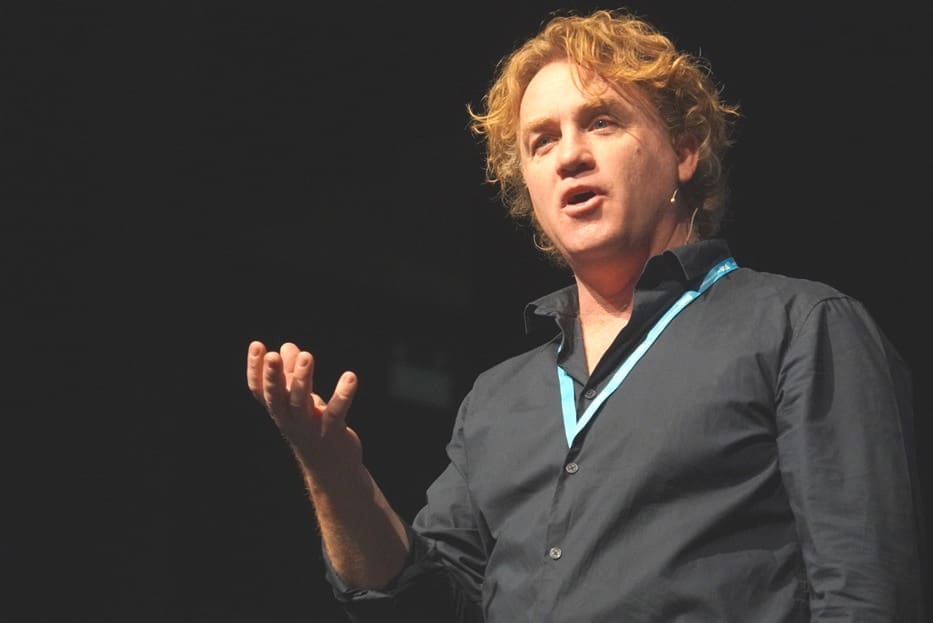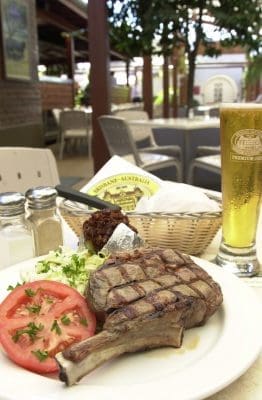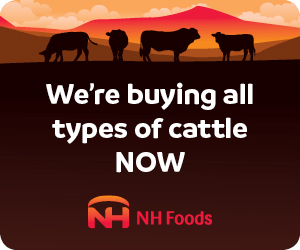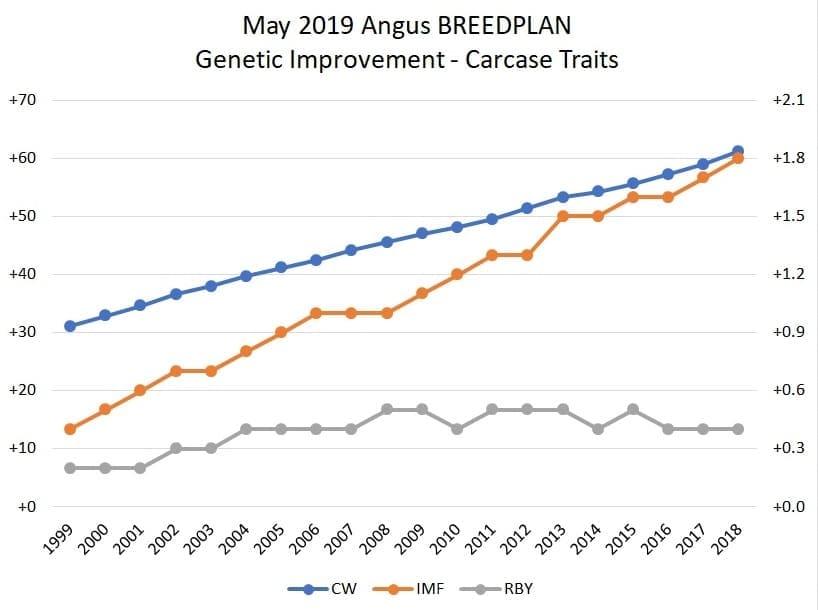
Melbourne celebrity chef Adrian Richardson: “Meat does not come from Ikea”
CARCASE weights have been rising relentlessly in Angus cattle in both Australia and the US over the past 30 years, and the subject came up several times in discussion during the Angus Through the Ages National Conference held in Albury last week.
In the US industry, fed steer carcase weights have consistently averaged above 900 pounds (410kg) in recent years. That has translated into extremely large primals like striploins and rib eyes, which create problems when trying to portion-cut steaks to a steak serve weight, without becoming too thin. In some extreme cases, US portion cutters have been forced to cut traditional steak cuts in half, in order to retain a reasonable thickness. US market analyst Dr Len Steiner told an Australian makret briefing in December that carcase weight and cuts size was a growing problem in the US industry.
While not yet approaching the extremes seen in the US, carcase weights have also continued to trend upwards in Australia over the past 30 years, rising 2kg/year on average since 1989.
While the drought has checked the trend briefly this year, MLA anticipates carcase weights (all adults slaughter cattle, grass and grainfed, including cows and yearlings) are to rise above 300kg for the first time in 2021, continuing the long-term trend.
While recognising that larger and larger cuts could create problems in some parts of the food service industry, celebrity chef Adrian Richardson told the conference that in his own business (La Luna restaurant in Melbourne), meat quality, and the consistency of quality, trumped larger primal cut weights as the primary concern.
“But for other food service applications – like functions at the MCG for example, where thousands of steaks might be served at a single sitting – there is a definite preference for smaller primals to cut steaks from,” he said. “They like consistent smaller product that they can fit on their plates and still have a reasonable cut thickness, per serve.”
“But to my business, that is less important. For us, it is more about the quality than the cut size. Is a larger animal going to make the meat better? In our case, that’s the more important consideration.”
Mr Richardson said the day before he had arrived at last week’s Angus conference, he had been boning sides of beef for his restaurant and noticed the striploins and cubes were ‘quite large.’
“It certainly means we will have to portion-cut those steaks thinner, in order to keep to a desired serve weight,” he said. “Being thinner also means we will have to take more care during service, to avoid over-cooking,” he said.
“I got the three boys who will be cooking those steaks together and we went through the challenges with them – that’s it’s a bigger, but thinner cut and is going to cook differently.”
“To me, if the industry is going to be changing the size of steak cuts (through advances in carcase weights, and hence, primals), we (chefs) are going to have to think about our cooking method more.”

Challenge for steakhouse chains
MLA’s executive chef Sam Burke said many food service operators using beef – such as pub groups – wanted that consistent 250 gram of 300 gram porterhouse or scotch fillet, and did not necessarily have the skills base among grill cooks to manage steaks cut to different thicknesses due to using different sized primals.
“They’re going to struggle,” Mr Burke said. “The bigger food service groups often want a smaller primal, so they can cut a thicker steak to a weight spec, and get the ideal degree of doneness, time and time again.
“It’s the biggest problem I’m seeing out there in the marketplace, among those bigger corporate hotel steakhouse chains,” Mr Burke said.
“Meat does not come from Ikea”
Adrian Richardson agreed that cut size could be a challenge for some food service operators, but said it was important to remember that “beef does not come from Ikea.”
“It’s harvested from a living animal, and no two are the same. Red meat is a big part of our restaurant business – we have our own in-house butcher in the restaurant – and those discussions (carcase weight, primal size and portion size and thickness) happen every single week, in how we manage the differences when each consignment comes through,” he said.
“It’s the big, high-turnover places that are more likely to struggle. But I don’t know how you, as cattle producers, can do much – in trying to push every animal through a little tiny slot. That’s a hard thing. It’s more about better training for line chefs, and giving them the tools to better understand and react to the differences that come through. But in the kitchen, staffing is an issue – it’s hard to get staff to turn up to work sober and straight, let alone cook anything.”
Carcases ‘way too big’
Glen Rowan, VIC Angus producer Rob Williams attended the conference, saying the question of excessive carcase weight was one of the most important topics Angus breeders needed an answer for over the two days of the gathering.
“Looking at the two largest wholesalers of Certified Angus beef in the US, in Boston and LA, since the 1980s they have been saying that the US Angus carcases are way too big,” he said.
“Our Breedplan 600-day weights in the mid-1980s was +26 – now the figure is 104kg. It’s an issue that needs very sincere assessment,” Mr Williams said during a question session.
 “Carcase and cut size is obviously an issue that the industry is coming up against, but for me, in my business, quality and consistency of quality is the most important thing,” Adrian Richardson told him. “But for other parts of food service, it’s obviously another thing altogether.”
“Carcase and cut size is obviously an issue that the industry is coming up against, but for me, in my business, quality and consistency of quality is the most important thing,” Adrian Richardson told him. “But for other parts of food service, it’s obviously another thing altogether.”
In a presentation on selection on terminal traits versus maternal traits, Massey University’s Dr Dorian Garrick told the conference that customers and processors had not driven the increases in carcase weight (growth) seen in the Angus industry, so much as producers themselves.
“You have just herd the discussion about carcases getting bigger and the size of those carcase is not being driven by the abattoir end or the customer end – it is being driven way back in the bull selection things that happened a couple of generations before those animals were born,” Dr Garrick said. So yearling weights are going up, weaning weights are going up, and carcase weights are going up.”
There had been tremendous improvements in lifting the profitability of those steers through a feedlot system – both in terms of cost of production and in terms of the value of the material they are selling. But while it is very easy to get excited about these 400 gram steaks in the restaurant, we do have to balance this with the cost efficiency for the cow/calf producer, not the just the aspects about the product that is generated.”

Change in Angus carcase weights
In the Angus Breedplan carcase weight graph published above, the genetic change in Angus cattle since 1999 for dressed carcase weight at 750 days of age is plotted (blue line), alongside intra-muscular fat and retail beef yield.
Angus breed development & extension manager Andrew Byrne said since 1999, dressed carcase weight at 750 days in Angus had increased by about 30kg.
The trend had been fairly consistent, reflecting continued selection for increased growth in Angus cattle over that period, he said.
Mr Byrne said there had been some discussion within breed ranks over the potential negative impact that larger carcases was having on cuts size, but equally the overall selection in Angus cattle for improved carcase performance – be it weight, marbling or yield – was resulting in a far better product than what was being produced 20 years ago.
While continued genetic selection pressure for traits like growth and marbling that affect the profitability within the lotfeeding and processing sector would continue, there was an increased focus at present on balancing that with profitability of genetics within the cow/calf operations, he said.
Angus Australia, working with CSIRO, recently carried out a survey looking at different traits that Angus breeders were placing importance on within their breeding programs.
“While selection for carcase weight and particularly marbling remain very high in importance, there is now an increased focus on other traits that effect profitability in the cow/calf operations, including fertility, docility and structural soundness,” Mr Byrne said.
“Angus Australia’s advice to breeders is that they should place emphasis on each of the traits which are important within their breeding objective, based on the relative economic importance of those traits. A balanced approach is required.”
Mr Byrne said historically there had not been a lot of performance data collected for dressed carcase weight, but since the arrival of initiatives like the Angus Sire Benchmarking Program, a lot more performance information was being collected on Angus for dressed carcase weight at the abattoir.
“When combined with the utilisation of genomic technologies (about 20pc of Angus registered animals are now DNA tested each year), we are now able to identify animals that may have some differentiation in their genetics for dressed carcase weight, versus growth,” he said.



Carcass size is a continual problem across all sectors of the food service / food retail sector. From butcher shop through to fine dining restaurants. Adrian Richardson has dealt with this issue, having his own in house butcher who ‘manages the differences’ when each consignment. This is a bespoke approach to meat selling which does not apply to 99% of the retail sector. Primal sizes are too big. Which results in all sorts of compromises being made on what is delivered to customers. Steaks cut too thin, funky things like ‘Rump Cap’ being invented to manage a 8.5kg rump. So your average evening shopper buys a piece of ‘Rump’ from Woolworths, and it is actually a piece of Rump Cap. The consumer ends up being the loser, paying big $$ for an inferior eating experience. Although Dr Garrick believes this has not been driven by the abattoir, I would argue they will enjoy the ride for as long as it can be extended. It would make poor business sense to bone out a 260kg carcass vs a 340kg carcass unless there was a strong financial incentive to do so. In a relatively buoyant cattle market like we are currently enjoying, the cost of these trends may not be felt. But if some fundamentals shift, and Australian Beef faces some stiff competition in the international market, then as an industry these trends will matter. And when the domestic consumer matters again, these trends will matter. The group that decides to grow a beast that consumers/retailers/restaurants actually want, will be the group out in front when the head winds of competition pick up.
I couldn’t agree more Steve Taylor.
The conclusion from this article, with persepctives from all sides of the production cycle, suggest that the only person benefitting from larger carcases is the processor.
For everyone else, primarily the cow/calf producer, the larger the carcase, the less efficient it is, and thus, the less profitable it is.
Surely at some stage our commercial industry has to acknowledge an area of optimal growth for the benefit of our entire production chain efficiency.
The industry obsession with selection for extreme growth is having a negative effect on commercial cow function and maintenance requirements.
This issue has also emerged in the lamb industry and the approach through recent Sheep CRC work has been to develop a new cut for the FQ which has seen others developed by the industry.